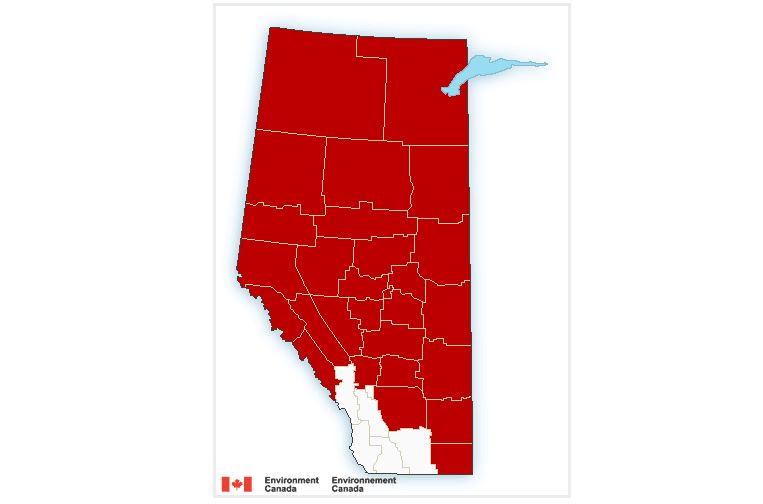Edmonton and much of central Alberta are heading into the coldest stretch of winter so far this year.

A ridge of high pressure will drag an Arctic air mass south from the Northwest Territories into Alberta by Monday morning, according to Environment and Climate Change Canada.
READ MORE: Calgary hit with snow, plunging temperatures ahead of weekend
Meteorologist Sara Hoffman said the Arctic air will translate to frigidly cold temperatures through the weekend and into next week.
“It’s already cold and it will continue to get colder over the weekend,” she said. “Tomorrow will be colder, Sunday will be colder and it will culminate in Monday morning being the coldest temperatures.
“Edmonton could be on the edge of that -40 C to -45 C range by Monday morning.”
Hoffman said the coldest temperatures will stretch from Edmonton east through central Alberta to the Lloydminster area, and up through the Cold Lake and Coronation region. It’ll feel even colder with the wind chill factored in.
“Certainly by Monday morning a wind chill value of -45 to -47 is entirely possible,” she said of the Edmonton and central Alberta regions.
“It’s also going to continue its way past Edmonton and make its way into Saskatchewan and Manitoba. So it’s a Prairies-wide thing. Misery loves company, I guess, so we’ll all be in it together.”
And once the cold temperatures settle in, they won’t be going anywhere too quickly.
“When we get these cold air outbreaks, especially these Arctic cold air outbreaks, they do tend to last about a week to two weeks’ time. It’s quite hard to move this cold air once it’s entrenched itself over an area,” Hoffman explained.

Get breaking National news
“We’re expecting well below normal temperatures to persist well through next week and potentially last through next weekend.”

Extreme cold warnings were in place for much of northern and eastern Alberta Friday afternoon and were expected to be expanded farther south.
The extreme cold warning included Edmonton, St. Albert and Sherwood Park by Saturday afternoon, with wind chill values between -40 C and -50 C expected into next week.
“If it’s too cold for you to stay outside, it’s too cold for your pet to stay outside,” Environment Canada said.
On Thursday, Edmonton activated its extreme cold weather response, which means two ETS bus loops will be operating overnight, travelling between emergency shelters, transit centres and other key locations.
Anyone who sees somebody outside in distress is asked to call 211.
How common are these extreme temperatures?
When it comes to these extremely cold temperatures, Hoffman said Edmonton is no stranger these conditions, but it depends where you live.
“Cold on the Prairies is very common. In fact, we were looking back in recent history to see the last time that Edmonton saw -40 C. That’s not a wind chill index, that’s an absolute degrees Celsius temperature and the Edmonton airport has at least reached it in the last two years consecutively,” Hoffman said.
“We’re not stranger to this cold, especially in the outlying areas of Edmonton.”
However, she noted the weather station at Edmonton city centre hasn’t dipped to -40 C since 1972.
“It’s quite rare to reach that -40 C in the city centre, although not as rare for outlying areas and low-lying areas.”

How long will this cold stretch last?
Hoffman admits it’s tough to say exactly how long the below average temperatures will last. She said forecast models have the most accuracy one to seven days out. Forecasting beyond that is based on probability.
“Looking out beyond Valentine’s Day we have to look at, what is the probability of above or below normal temperatures?” Hoffman said.
“Beyond Valentine’s Day we’re looking at a high probability of below normal temperatures.”
She added the Environment and Climate Change Canada forecast for February calls for “well below normal temperatures for much of Canada.”

Hoffman reminds Albertans that with temperatures this low, exposed skin can become frostbitten in just minutes. Signs of frostbite include numbness and white, waxy skin. If you plan to spend any length of time outside, it’s recommended you layer up with a wind-resistant outer layer.
More information on frostbite and how to prevent it can be found on Environment Canada’s website.
Want your weather on the go? Download the Global News Skytracker weather app for iOS and Android.









Comments